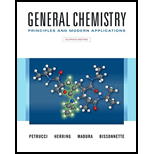
(a)
Interpretation:
The normal boiling point of mercury needs to be determined.
Concept introduction:
The standard entropy and standard enthalpy of vaporization is related to boiling point with formula
The Clausius−Clapeyron relation expresses the relation between the pressure with enthalpy and temperature. The mathematical expression for Clausius−Clapeyron relation can be written as
(b)
Interpretation:
The vapor pressure of mercury at 25 ?C needs to be determined.
Concept introduction:
The standard entropy and standard enthalpy of vaporization is related to boiling point with formula
The Clausius−Clapeyron relation expresses the relation between the pressure with enthalpy and temperature. The mathematical expression for Clausius−Clapeyron relation can be written as
Want to see the full answer?
Check out a sample textbook solution
Chapter 13 Solutions
Mastering Chemistry With Pearson Etext -- Standalone Access Card -- For General Chemistry: Principles And Modern Applications (11th Edition)
- Data are given in Appendix 1 for white phosphorus, P4(s). P4(g) has the following thermodynamic values: Hf=58.9kJ/mol , S=280.0J/kmol . What is the temperature at which white phosphorus sublimes at 1 atm pressure?arrow_forwardUsing data from Appendix 4, calculate H, G, and K (at 298 K) for the production of ozone from oxygen: 3O2(g)2O3(g) At 30 km above the surface of the earth, the temperature is about 230. K and the partial pressure of oxygen is about 1.0 103 atm. Estimate the partial pressure of ozone in equilibrium with oxygen at 30 km above the earth's surface. Is it reasonable to assume that the equilibrium between oxygen and ozone is maintained under these conditions? Explain.arrow_forwardActually, the carbon in CO2(g) is thermodynamically unstable with respect to the carbon in calcium carbonate(limestone). Verify this by determining the standardGibbs free energy change for the reaction of lime,CaO(s), with CO2(g) to make CaCO3(s).arrow_forward
- The Ostwald process for the commercial production of nitric acid involves three steps: 4NH3(g)+5O2(g)825CPt4NO(g)+6H2O(g)2NO(g)+O2(g)2NO2(g)3NO2(g)+H2O(l)2HNO3(l)+NO(g) a. Calculate H, S,G and K (at 298 K) for each of the three steps in the Ostwald process (see Appendix 4). b. Calculate the equilibrium constant for the first step at 825C, assuming H and S do not depend on temperature. c. Is there a thermodynamic reason for the high temperature in the first step, assuming standard conditions?arrow_forwardThe standard free energy of formation of gaseous hydrogen iodide is 1.30 kJ/mol at 25°C. What is KP for the reaction H2(g) + I2(g) 2HI(g) at this temperature?arrow_forwardWhen in 1 atm of pressure, when is the reaction of formation of ozone from oxygen spontaneous? 3 O2 (g) → 2 O3 (g)arrow_forward
- For a certain chemical reaction, the standard Gibbs free energy of reaction at 15.0°C is −143. kJ. Calculate the equilibrium constant K for this reaction.arrow_forwardWhen are K꜀ and Kₚ equal, and when are they not?arrow_forwardIt is thermodynamically favorable for methane to autoigniteand burn at room temperature, but this does not occur.Explain.arrow_forward
- a) For the reaction given in Part A, how much heat is absorbed when 2.70 mol of AA reacts? (the image attached) b) For the reaction given in Part A, ΔS∘rxn is 39.0 J/K . What is the standard Gibbs free energy of the reaction, ΔG∘rxn?arrow_forwardif the initial pressure of A was 1.71atm, what would the partial pressure of A(in atms) at equilibrium? Kp=58 at 298K 2A(g)B(g)+C(g)arrow_forwardAmmonia reacts with water in liquid ammonia solution according to the equation: NH3(g) + H2O ⇌ NH4+ + OH− The change in enthalpy for this reaction is 21 kJ/mol, and ΔS° = −303 J/(mol·K). What is the equilibrium constant for the reaction at the boiling point of liquid ammonia (−31°C)?arrow_forward
 Principles of Modern ChemistryChemistryISBN:9781305079113Author:David W. Oxtoby, H. Pat Gillis, Laurie J. ButlerPublisher:Cengage Learning
Principles of Modern ChemistryChemistryISBN:9781305079113Author:David W. Oxtoby, H. Pat Gillis, Laurie J. ButlerPublisher:Cengage Learning Chemistry: Principles and ReactionsChemistryISBN:9781305079373Author:William L. Masterton, Cecile N. HurleyPublisher:Cengage Learning
Chemistry: Principles and ReactionsChemistryISBN:9781305079373Author:William L. Masterton, Cecile N. HurleyPublisher:Cengage Learning Chemistry: The Molecular ScienceChemistryISBN:9781285199047Author:John W. Moore, Conrad L. StanitskiPublisher:Cengage Learning
Chemistry: The Molecular ScienceChemistryISBN:9781285199047Author:John W. Moore, Conrad L. StanitskiPublisher:Cengage Learning Chemistry: An Atoms First ApproachChemistryISBN:9781305079243Author:Steven S. Zumdahl, Susan A. ZumdahlPublisher:Cengage Learning
Chemistry: An Atoms First ApproachChemistryISBN:9781305079243Author:Steven S. Zumdahl, Susan A. ZumdahlPublisher:Cengage Learning
 ChemistryChemistryISBN:9781305957404Author:Steven S. Zumdahl, Susan A. Zumdahl, Donald J. DeCostePublisher:Cengage Learning
ChemistryChemistryISBN:9781305957404Author:Steven S. Zumdahl, Susan A. Zumdahl, Donald J. DeCostePublisher:Cengage Learning





